EU Funds Available for Projects on Tyre and Road Wear Particles
Horizon Europe and LIFE Programme open the door to new projects aimed at addressing the issue posed by tyre and road wear particles (TRWP).
The European TRWP Platform has identified proposal topics and is looking for potential partners.
The new EU multiannual budget 2021-2027 can offer great financing opportunities for projects on tyre and road wear particles. Speaking at the online meeting of the European Tyre and Road Wear Particles Platform on May 27th , representatives from the European Commission highlighted in particular the funding available within Horizon Europe - the EU’s key funding programme for research and innovation - and the LIFE programme - the EU’s funding instrument for the environmental and climate action since 1992.
Horizon Europe can finance research projects to fill the numerous scientific knowledge gaps on tyre and road wear particles (TRWP). For instance, the recently published work programme for 2021-2022 includes interesting opportunities for funding projects on TRWP-related topics in the thematic cluster “Clean and competitive solutions for all transport modes”.
The LIFE programme, on the other hand, cannot be used to finance pure research but rather for practical solutions that are ready to be implemented in close-to-market conditions during the course of the project. The category that would best suit TRWP-related projects among the new priorities of the LIFE programme is “Circular Economy and Quality of Life - Standard Action Projects”.
CALL FOR PROPOSALS ON TRWP
During the meeting, the European Tyre and Road Wear Particles Platform laid down some ideas for potential new projects with a focus on:
The influence of the road surface on TRWP emissions: to analyse the quantitative correlations between the road surface characteristics and TRWP emissions.
The cost-benefit analysis of different mitigation measures: to provide a systematic quantification of the consequences of each mitigation measure to identify the best trade-offs.
The impact of electric mobility: to study the effects of electric mobility on the generation of TRWP, including the analysis of driving behaviour.
Would you like to collaborate on any these ideas? Or do you have a project proposal to mitigate TRWP? Let us know! Contact Elisa Casazza, Senior Project Manager.
Now that the Horizon Europe programme is fully operative, we strongly encourage researchers, innovators, and citizens from all over the EU to apply to contribute to shaping it.
ABOUT THE EUROPEAN TRWP PLATFORM
When you are driving, your vehicle is kept on the road by the friction between the tyres and the road pavement. Without this friction, the vehicle would slide over the road, increasing the chances of accidents and putting at risk your safety.
However, a consequence of this friction is abrasion, causing particles to rub off from both the tyre and road surface. These are called “tyre and road wear particles” (TRWP) as they are composed of a mixture of approximately 50% tyre tread fragments and 50% road surface elements.
Due to their size and composition, these particles are commonly considered microplastics and, as such, are tacked by the European Commission in its Plastics Strategy, European Green Deal and Circular Economy Action Plan.
Reducing the generation of TRWP is complex because:
The friction between tyre and road is essential to ensure drivers safety;
The quantity of TRWP generated does not depend only on tyre design but are affected by several external factors, such as the road characteristics (surface and topology), the vehicle characteristics, the driving behaviour and the weather conditions.
Therefore, to address this challenge, a multi-sectorial and holistic approach is needed.
This is why the European Tyre and Road Wear Particles Platform was launched in July 2018 by the European Tyre & Rubber Manufacturers Association (ETRMA). The platform is a multi-stakeholder, cross-sector initiative facilitated by CSR Europe to share scientific knowledge and co-create mitigation actions to reduce the generation and transportation of TRWP into the environment. Over 30 organisations from the industry, research institutes, public authorities, and civil society organisations are currently part of the TRWP Platform.
SOME SOLUTIONS TO TRWP ALREADY EXIST
Even though TRWP is a relatively new field - and a very complex one - some mitigation measures are already in place. One example that was discussed during the last Platform meeting is, for instance, a project implemented by the Danish Road Directorate and the Aalborg University, which are testing a new method to remove microplastics along a busy Danish motorway through rainwater basins equipped with special filters.
This project is completely funded by the Danish Road Directorate, but it represents an inspiring example of the type of projects that could be funded by the European Union, for instance by the LIFE Programme.
This project started in 2009 when the Danish Road Directorate wanted to develop new treatment methods for road runoff to protect very sensitive aquatic environments near a planned new high highway in Jutland (Denmark).
The innovative treatment method elaborated by the Aalborg University initially aimed at removing metals, nutrients, suspended solids, and reducing the temperature of the runoff water, but from recent studies, it seems to also be able to capture microplastics too. Further studies on how many microplastics particles are retained in the sedimentation ponds are currently ongoing but the preliminary results seem very promising.
This is only one example among several other potential mitigation measures to reduce the generation of TRWP and increase their capture. The European TRWP Platform has summarised the most promising ones in the Way Forward Report. The report provides recommendations for individual action from each sector - such as tyre makers, automotive, road makers, etc. - as well as pathways for continued cross-sectorial collaboration.
RELATED RESOURCES
UPCOMING EVENTS
SERVICES







